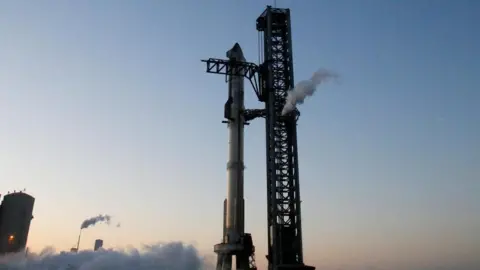
The United States has grounded SpaceX’s giant Starship rocket while it investigates the cause of its explosion during a recent test flight.
The rocket’s upper stage sharply fractured and disintegrated over the Caribbean Sea after launching from Texas on Thursday, forcing airline flights to change course to avoid falling debris.
The U.S. Federal Aviation Administration (FAA) said it was working with SpaceX and other authorities to confirm reports of damage to public property in the Turks and Caicos Islands. There were no reports of injuries.
Elon Musk’s company has been told to conduct an “accident” investigation by aviation regulators, who will review the findings before deciding whether Starship can return to flight.
The FAA confirms it has activated a “debris response zone” to temporarily slow down aircraft outside the zone where the pieces fellor prevent the aircraft from leaving its departure point.
It added that several aircraft were stranded outside the affected area and required diversions due to low fuel.
 Reuters
ReutersStarship is the largest and most powerful rocket ever built and is key to Musk’s ambition to colonize Mars.
Thursday’s uncrewed launch was Starship’s seventh test mission and the first involving a taller, upgraded rocket.
SpaceX said before the test that the Starship upper stage is 2 meters (6.56 feet) taller than the previous version and is “a new generation of spacecraft that has undergone significant upgrades.”
It was scheduled for a controlled splashdown in the Indian Ocean about an hour after launch from Boca Chica, Texas.
The Starship system lifted off at 17:38 EDT (22:38 GMT), flying as planned for nearly four minutes before the upper stage separated from its Super Heavy booster.
But then SpaceX communications manager Dan Huot reported on the live broadcast that the mission team lost contact with the spacecraft.
The Super Heavy booster successfully returned to the launch pad about seven minutes after liftoff as planned, eliciting bursts of applause from the ground control team.
SpaceX later confirmed that the upper stage had undergone a “rapid unscheduled disassembly.”
Musk posted on his social media platform
The billionaire added that “so far there is no indication that the next launch will be delayed beyond next month”.
 Reuters
ReutersSpaceX’s Starship spacecraft and Super Heavy rocket, collectively known as Starship, are 123 m (403 ft) tall and designed to be fully reusable, the company said.
NASA hopes to use an improved version of the rocket as a manned lunar lander for its Artemis mission back to the moon.
In the more distant future, Musk hopes Starship will be able to make long-distance trips to Mars and back — about nine months each way.
 Reuters
ReutersThe Starship test launch on Thursday came just hours after the first flight of Blue Origin’s New Glenn rocket system, backed by Amazon boss Jeff Bezos.
It’s a big step forward for Bezos and company, which have spent years getting the rocket into orbit.
Both Bezos and Musk want to dominate the space vehicle market.








